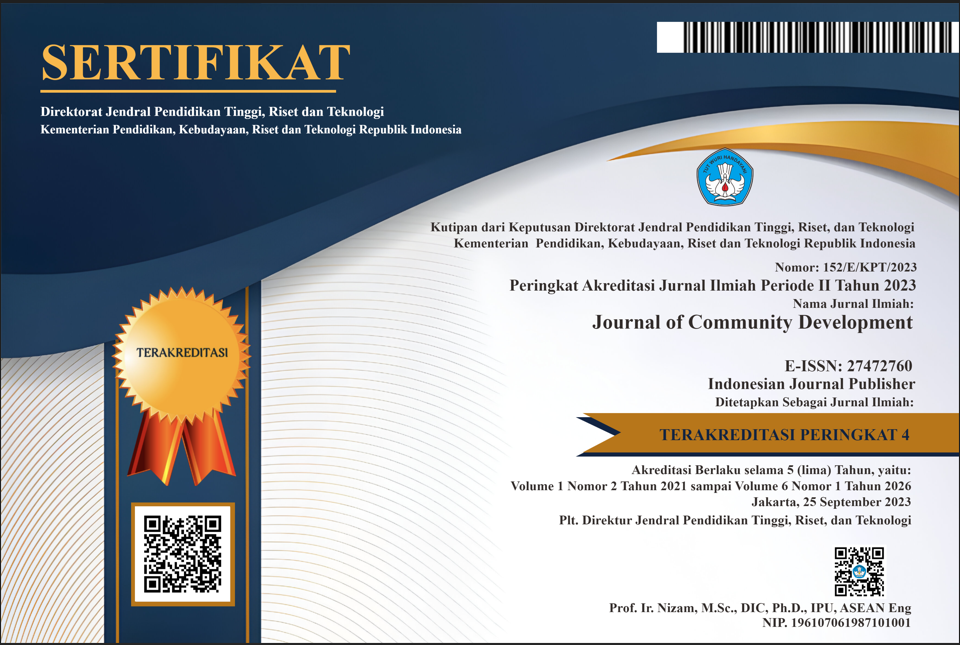Pemanfaatan Limbah Daun Jati Kering dan Serbuk Gergaji Kayu sebagai Bahan Baku Arang Briket di Desa Bubulan
DOI:
https://doi.org/10.47134/comdev.v4i3.167Keywords:
Dried teak leaves, wood sawdust, charcoal briquettes, charcoal carbonizationAbstract
The Bubulan Village has rich natural resources, one of which is high-quality teak trees contributing to the productivity of teak trees in Bojonegoro Regency. Despite its advantages, teak trees in Bubulan Village hold the potential for economically valuable waste, namely teak leaf waste accumulating in the forest area. Additionally, Bubulan Village is home to wooden furniture craftsmen, and every production process generates wood sawdust waste.This community service aims to empower the people of Bubulan Village in managing this waste through training on the utilization of dried teak leaf waste and wood sawdust as raw materials for charcoal briquettes. The service method begins with partner surveys, followed by reference studies and a simulation of the charcoal-making process by the team. Subsequently, tools for making charcoal briquettes (including the creation of a charcoal stove) are procured. The activities continue with outreach to showcase the potential of Bubulan Village, followed by training on the utilization of teak leaf waste and wood sawdust as raw materials for charcoal briquettes.Representatives from the youth organization (karang taruna), village officials, and 20 residents of Bubulan Village attended this community service. The outcomes of this service include an increase in participants' knowledge about charcoal briquettes made from dried teak leaves and wood sawdust by 49%. The designed and made charcoal stove by the service team functions well. Briquettes made from dried teak leaves ignite more easily but have a shorter burning duration compared to briquettes made from wood sawdust. Further testing is needed to determine the calorific value, ash content, and moisture content of these briquettes, as well as additional tests on the efficiency of the charcoal stove.Written in English with a distance between sentences of 1 space and the number of words between 150-250. The abstract should contain introductions, methods, results and discussions and conclusions (without citation). Avoid using citations in the abstract.
Downloads
References
Irawan J. Jati Bojonegoro Masih Menjadi Primadona Mancanegara [Internet]. Radar Bojonegoro. 2022. Available from: https://radarbojonegoro.jawapos.com/pembaca/711317835/jati-bojonegororo-masih-menjadi-primadona-mancanegara
Sukowati D, Yuwono TA, Nurhayati AD. Analisis Perbandingan Kualitas Briket Arang Bonggol Jagung denganArang Daun Jati. PENDIPA J Sci Educ. 2019;3(3).
Sari PN, Aminah S. Pemanfaatan Serbuk Gergaji sebagai Bahan Baku Briket. Media Eksakta. 2020;16(2).
Hidayat R, Dwityaningsih R, Haarjanto TR. Pembuatan Briket dari Serbuk Kayu dan Daun Jati Kering Menggunakan Molase sebagai Bahan Perekat. J Rekayasa Bahan Alam dan Energi Berkelanjutan. 2022;6(2):14–9.
Santosa S, Soemarno. Peningkatan Nilai Kalor Produk pada Produk Proses Bio-drying Sampah Organik. Indones Green Technol J [Internet]. 2014;3(1). Available from: https://igtj.ub.ac.id/index.php/igtj/article/view/119
Sondakh RC, Hayatudin, Ernawati. Perbandingan Biomassa Pertanian Sebagai Energi Terbarukan Briket Arang. J Ilm GIGA. 2022;25(1):45–52.
Putri RE, Andasuryani. Studi Mutu Briket Arang dengan Bahan Baku Limbah Biomassa. J Teknol Pertan Andalas. 2017;21(2):143–51.
Ridhuan K, Irawan D, Inthifawzi R. Proses Pembakaran Pirolisis dengan Jenis Biomassa dan Karakteristik Asap Cair yang Dihasilkan. TURBO. 2019;8(1).
Fahmy T, Fahmy Y, Mobarak F, El-Sakhawy M, Abou-Zeid R. Biomass pyrolysis: past, present, and future. Environ Dev Sustain. 2018;22.
Faizal M, Andynapratiwi I, Putri P. Pengaruh Komposisi Arang dan Perekat terhadap Kualitas Biobriket dari Kayu Karet. J Tek Kim. 2014;20(2).
Prasetiani CF, Suwandi, Iskandar RF. Pengaruh Jenis Biomassa dan Kecepatan Aliran Udara Terhadap Kinerja Kompor Gasifikasi Biomassa. e-Proceeding Eng. 2019;6(2).
Suryani E, Farid M, Mayub A. Implementasi Karakteristik Nilai Kalor Briket Campuran Limbah Kulit Durian dan Tempurung Kelapa pada Pembelajaran Suhu dan Kalor Di SMPN 15 Kota Bengkulu. PENDIPA J Sci Educ. 2019;3(3).
Fathonah W, Kusuma RI, Wigati R, Mina E, Aditya MR. Pemanfaatan Limbah Sekam Padi Menjadi Briket sebagai Upaya Inovasi Potensi Lokal di Desa Panenjoan. Kacanegara J Pengabdi Pada Masy. 2023;6(2).
Supramono D, Inayati F. Performance of a Biomass-Gas Stove using Fuel of Rubber Wood Pellets. Int Conf Qual Res. 2013;13.
Sharma T, Maya DMY, Nascimento FRM, Shi Y, Ratner A, Silva Lora EE, et al. An Experimental and Theoretical Study of the Gasification of Miscanthus Briquettes in a Double-Stage Downdraft Gasifier: Syngas, Tar, and Biochar Characterization. Energies. 2018;11(11).
Downloads
Published
How to Cite
Issue
Section
License
Copyright (c) 2024 Hery Indria Dwi Puspita, Gandu Eko Julianto Suyoso, Rudianto, Andi Sanata, Ahmad Yasim

This work is licensed under a Creative Commons Attribution 4.0 International License.







